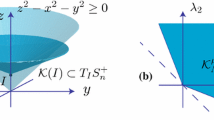Abstract
In the theory of Fourier transform some functions are said to be positive definite based on the positive definiteness property of a certain class of matrices associated with these functions. In the present article we consider how to define a similar positive definiteness property for arithmetical functions, whose domain is not the set of real numbers but merely the set of positive integers. After finding a suitable definition for this concept we shall use it to construct a partial ordering on the set of arithmetical functions. We shall study some of the basic properties of our newly defined relations and consider a couple of well-known arithmetical functions as examples.
Access this chapter
Tax calculation will be finalised at checkout
Purchases are for personal use only
Similar content being viewed by others
References
Altinisik, E., Sagan, B. E., & Tuglu, N. (2005). GCD matrices, posets, and nonintersecting paths. Linear Multilinear Algebra, 53, 75–84.
Apostol, T. M. (1976). Introduction to analytic number theory. Berlin: Springer.
Bhatia R. (2006). Infinitely divisible matrices. American Mathematical Monthly, 113:3, 221–235.
Bourque, K., & Ligh, S. (1993). Matrices associated with arithmetical functions. Linear and Multilinear Algebra, 34, 261–267
Encyclopedic Dictionary of Mathematics (1987). Cambridge, MA: MIT Press.
Graham, R. L., Knuth, D. E., Patashnik, O., & Liu, S. (1994). Concrete mathematics: A foundation for computer science (2nd ed.). Reading, MA: Addison-Wesley.
Gould, H. W. (2010). Fundamentals of series: Table II: Examples of series which appear in calculus. Retrieved May 3, 2010, from http://www.math.wvu.edu/~gould/Vol.2.PDF
Hong, S., & Loewy, R. (2004). Asymptotic behavior of eigenvalues of greatest common divisor matrices. Glasgow Mathematical Journal, 46:3, 551–569.
Horn, R. A., & Johnson, C. R. (1985). Matrix analysis. Cambridge: Cambridge University Press.
Horn, R. A., Johnson, C. R. (1991). Topics in matrix analysis. Cambridge: Cambridge University Press.
Ilmonen, P., & Haukkanen, P. (2011). Smith meets Smith: Smith normal form of Smith matrix. Linear Multilinear Algebra 59:5, 557–564.
McCarthy, P. J. (1986). Introduction to arithmetical functions. Berlin: Springer.
Mattila, M., & Haukkanen, P. (2014). On the positive definiteness and eigenvalues of meet and join matrices. Discrete Mathematics, 326, 9–19.
Ovall, J. S. (2004). An analysis of GCD and LCM matrices via the LDL T-factorization. Electronic Journal of Linear Algebra, 11, 51–58.
Rajarama Bhat, B. V. (1991). On greatest common divisor matrices and their applications. Linear Algebra and its Applications, 158, 77–97.
Sándor, J., Crstici, B. (2004). Handbook of number theory II. Dordecht: Kluwer.
Smith, H. J. S. (1875–1876). On the value of a certain arithmetical determinant. Proceedings of the London Mathematical Society, 7, 208–212
Acknowledgement
The authors wish to thank the reviewers for valuable comments and suggestions that helped us to improve this paper.
Author information
Authors and Affiliations
Corresponding author
Editor information
Editors and Affiliations
Rights and permissions
Copyright information
© 2019 Springer Nature Switzerland AG
About this paper
Cite this paper
Mattila, M., Haukkanen, P. (2019). A Notion of Positive Definiteness for Arithmetical Functions. In: Ahmed, S., Carvalho, F., Puntanen, S. (eds) Matrices, Statistics and Big Data. IWMS 2016. Contributions to Statistics. Springer, Cham. https://doi.org/10.1007/978-3-030-17519-1_5
Download citation
DOI: https://doi.org/10.1007/978-3-030-17519-1_5
Published:
Publisher Name: Springer, Cham
Print ISBN: 978-3-030-17518-4
Online ISBN: 978-3-030-17519-1
eBook Packages: Mathematics and StatisticsMathematics and Statistics (R0)




